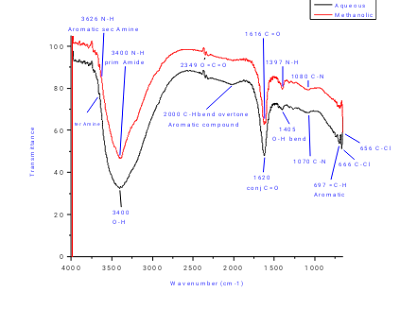Working principle & Instrumentation
 |
| FTIR instrumentation |
FTIR (Fourier Transform Infrared Spectroscopy) is analytical technique for determining functional group and crystal orientations. Their nature may be of organic or inorganic. FTIR contain IR source to produce IR radiation Interferometer (Michelson interferometer) which contain beam splitter, stationary mirror and moving mirror. Which split the beam into two beams two possiblities are,one is destructive interference called OPD (optical path difference) height and valley (crest and trough) of IR not match in beam spliter when it rejoin and cancel the effect of each other.
ZPD (zero path difference ) height and valley (crest and trough) of IR beams match is known as constructive interferences which gives results when fall on sample.
Basic principle is that electrons between different elements absorbed IR radiations at different frequencies matching to it in the range in FTIR this interaction (measures absorbance or emittence) These signals are decoded by applying techniques Fourier transformation to produced spectra usually in the mid-IR region corresponds to wavenumbers 4000 to 400cm-1 .
Sample prepration Samples for FTIR analysis must be prepared in a form suitable for transmission or reflection of infrared light. This often involves creating thin films, in disc or KBr wafer method by using potassium bromide (KBr) 3:1 ratio (3% KBR : 1% sample) mix well with each other grinding, mashing then place it in pressing disc press through hydraulic press applying pressure of 8 to 10 mega pascal to attain very thin crackless pellet place it in analyzer chamber to analyze. In direct method Liquids can analyize directly droping few drops on analyzer The goal is to present a uniform and representative sample.
Results interpretation FTIR spectra display peaks at specific wavenumbers corresponding to molecular vibrations. Peaks indicate the presence of certain functional groups or bonds. The intensity and position of these peaks provide information about the concentration and type of chemical bonds in the sample.
Upto 4000cm-1 to 1500cm-1 is Known as functional group region 1500cm-1 to 400cm-1 known as finger print region specific for each material, match the spectra with IR data base to identify the functional group and materials.
 |
| FTIR spectra |


.jpeg)